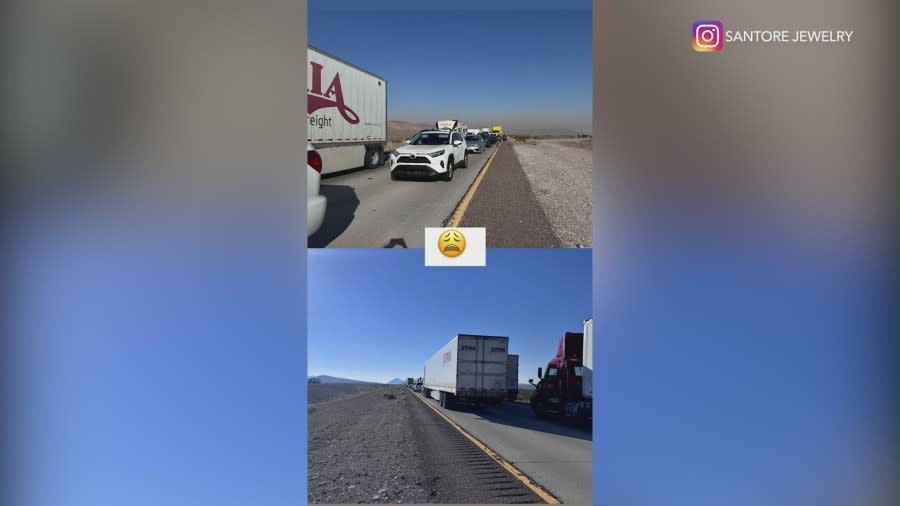Motorists Stuck Between L.A. and Las Vegas as a ‘Hard Closure’ on I-15 Stifles Traffic
The transportation network that links Los Angeles and Las Vegas, particularly Interstate 15 (I-15), is an essential arterial route that sees an extensive volume of traffic, particularly during weekends and holidays when many travelers embark on their journeys to the entertainment capital of the world. However, on an otherwise ordinary Friday, a significant incident occurred that would become a nightmare for many motorists planning to cruise through the Mojave Desert.
The ordeal began early in the morning when an overturned big rig—a large commercial truck—crashed just off I-15 near the Afton Road exit, which sits approximately halfway between Barstow and Baker. This was not just any truck; it was transporting lithium batteries, a substance that is notorious for its hazardous nature, particularly when exposed to fire or improper handling. The accident resulted in an immediate and intense fire, causing both a hazmat situation and a subsequent decision by the authorities to impose a hard closure on the northbound lanes of this critical freeway.
In the early hours, shortly after the accident, it became evident that the fire was far from being contained. Firefighters from the San Bernardino County Fire Protection District faced extreme challenges in managing the fire due to its location. Providing adequate fire response in the desert terrain is always complicated, and in this case, the considerable distance between the incident site and nearby fire stations meant that response times were significantly hampered. For approximately 14 hours, the fire raged, leading to traffic being completely stifled on the northbound lanes and resulting in an unprecedented bottleneck of vehicles.
By the time night fell on Friday, thousands of motorists found themselves caught in a standstill. Gas stations brimming with anxious travelers turned into makeshift shelters as frustrated drivers resorted to sleeping in their vehicles, attempting to conserve food and water reserves. Reports began to trickle in about the experiences of those stranded on this interstate spine. Notably, a KTLA viewer named Katryn Santore described her experience, stating, “I’ve been on the road since yesterday. I left Los Angeles around 11 a.m…. I was stuck on the 15 from about 2:30 p.m. to about 9:30 p.m.”
As the hours wore on, emergency responders worked tirelessly to manage the hazmat situation. By Saturday morning, the California Highway Patrol (CHP) provided a critical update: while the fire was still smoldering, air quality had sufficiently improved, allowing them to cautiously open one lane of I-15 for southbound travel around noon. However, the northbound lanes remained indefinitely closed, emphasizing the ongoing challenges of the situation.
With adverse weather conditions and extended waits threatening to worsen the plight of those stranded, officials began to recommend alternative routes, such as Interstate 40, though it was anticipated that this detour would still face its own traffic complications. As of Saturday afternoon, those planning a trip to Las Vegas were facing an acute dilemma—many were left to weigh the pressing concerns of dwindling fuel against the risks of getting stuck in yet another jam.
The state of emergency continued as authorities monitored the scene, with scientists from both Los Angeles and San Bernardino counties preparing to conduct hazmat testing. However, they noted that it would take several hours before testing could commence, causing further uncertainty for those stuck in the never-ending queue of vehicles. By late Saturday afternoon, officials reiterated that the closure would remain in place “for an unknown time,” citing continued concerns regarding the hazardous materials involved, and clarifying that the hazardous material had yet to stabilize and be safely removed.
In sum, the incident highlighted the crucial nature of effective emergency response mechanisms and the vulnerability of major transport arteries in unforeseen circumstances. It was a stark reminder of the importance of safety regulations regarding the transportation of hazardous materials, especially as more motorists flock to our highways for weekend escapes. As the situation progressed, it laid bare the compelling need for individuals to remain prepared—keeping supplies on hand in vehicles and maintaining a clear plan for unforeseen travel emergencies. For the travelers caught on the I-15, their anticipated excursions turned into a challenging tale of patience, perseverance, and waiting for the safe reopening of this vital thoroughfare.
